Hot Stamping Parts Shear Mold Manufacturing via Metal Additive Manufacturing
Abstract
1. Introduction
2. Research Method
2.1. Research on Metal Powder for AM
2.2. Examination of the AM Process Involving Metal Powder Material
2.3. Examination of Heat Treatment Process for AM Metal Powder Materials
2.4. Shear Analysis
2.5. Mold Fabrication
3. Results
3.1. Evaluation of AM_A, AM_B, and Forging_C Mechanical Properties
3.1.1. Tensile Strength Evaluation of AM Materials
3.1.2. Bonding Strength Evaluation of AM Materials
3.1.3. Unnotched Impact Test Evaluation of AM_A, AM_B, and Forging_C
3.1.4. Microstructural Analysis of AM_A, AM_B, and Forging_C
3.2. Mold Life Evaluation
4. Conclusions
- (1)
- Two functional metal alloy powders that could be used in the functional parts of shear steel were developed based on the main principles of the metal AM process, the alloy components of the commercial forging material, and the hardness values after heat treatment. The developed material was able to achieve a hardness of 58 HRC or higher via AM without the application of heat treatment, unlike for a commercial mold steel forged material.
- (2)
- To improve the mechanical properties of the developed metal powder material after AM, the changes in mechanical properties due to the application of heat treatment were evaluated via an impact test after the application of heat treatment. No improvement was observed in the impact test results for the heat-treated AM material relative to those for the non-heat-treated material. It was determined that the mechanical properties of the material did not improve even when additional heat treatment was applied to the laminated material, because of the occurrence of quenching after melting at a high temperature during the manufacturing process.
- (3)
- After evaluation of the various mechanical properties of Forging_C, which is known to have the best mechanical properties required for shear steel among laminated and commercial forging materials presently available, a shear lifetime evaluation was conducted to test the durability of the AM materials for 100,000 cycles. The AM_A material was determined to have a durability of 90,000 cycles, similar to that of Forging_C. However, the impact value of AM_A, which is an important mechanical property required for shear steel, was evaluated to be as low as 20% of that of Forging_C when compared at similar hardness values. Therefore, it was concluded that the lifespan of the AM_A shear steel does not appear to be in proportion to the mechanical properties. To investigate this discrepancy, the microstructures of the laminated and forged materials were observed using FESEM. For the forged material, precipitated phases were observed to be irregularly precipitated in the matrix structure, which was dependent on the application of heat treatment. By contrast, for the laminated materials, precipitated phases were either not observed or were observed to be precipitated in a regular pattern along the grain boundaries in the matrix structure. Therefore, it was concluded that the lifespan of the shear steel was affected by the distribution and characteristics of the microstructure, along with the mechanical properties of the material.
- (4)
- The shear steel composed of the non-heat-treated AM_A material and that composed of the heat-treated Forging_C material exhibited the highest lifetimes. However, because the Forging_C material is from three to four times more expensive than D2, its commercial application is limited by the high mold manufacturing costs. By contrast, the AM material can be applied using the newly developed method on 1–2% of the functional parts of S45C, which is 70–80% cheaper than D2 and is used for 98–99% of the non-functional parts of all shear steel. Therefore, relative to conventional techniques, the newly developed method reduces the mold manufacturing cost. Additionally, based on both the mold manufacturing period and maintenance convenience, commercialization of the proposed method is possible.
Funding
Acknowledgments
Conflicts of Interest
References
- Lee, C.M.; Kim, J.H.; Oh, W.J.; Ryu, B.H. A Study on the Analysis for Upper Seat Track of Automobile Using 1180 MPa Ultra-High Strength Steel. J. Korean Soc. Precis. Eng. 2017, 34, 525–531. [Google Scholar] [CrossRef]
- Murata, T.; Hamamoto, S.; Utsumi, Y.; Yamano, T.; Futamura, Y.; Kimura, T. Characteristics of 1180 MPa grade cold-rolled steel sheets with excellent formability. Kobelco Technol. Rev. 2017, 45, 17–20. [Google Scholar]
- Uemori, T.; Naka, T.; Tada, N.; Yoshimura, H.; Katahira, T.; Yoshida, F. Theoretical predictions of fracture and springback for high tensile strength steel sheets under stretch bending. Procedia Eng. 2017, 207, 1594–1598. [Google Scholar] [CrossRef]
- Kim, J.S.; Jo, N.H. Lightweight Materials for Automotive; Technology Trend Report; KISTI: Seoul, Korea, 2018. [Google Scholar]
- Choi, H.S. Vehicle Lightweight Technology Transferred from Aircraft. KAMA Web J. 2016, 325. [Google Scholar]
- Size, A.M. Share and Trends Analysis Report by Form (Blanket, Particle, Panel, Monolith), by Product (Silica, Carbon, Polymers), by End Use, by Technology, by Region, and Segment Forecasts, 2018–2025. Grand View Research. Available online: https://www.giikorea.co.kr/report/bc1044191-global-market-plastics-compounding.html (accessed on 8 January 2021).
- Jung, I.S.; Moon, M.S. Development Trends and Applications of Lightweight Carbon Composites for Automobiles; Information Analysis Report; KISTI: Seoul, Korea, 2015; pp. 18–26. [Google Scholar]
- Choe, S.B.; Kim, S.W.; Jeong, S.K. Automotive Lightweight Technology Trends and Development Strategies; Information Analysis Report; KISTI: Seoul, Korea, 2013; pp. 1–7. [Google Scholar]
- Won, S.T.; Kim, J.D.; Kim, D.U.; Kim, G.H.; Yoon, G.S. Trends of Press Forming Industry and Technology. Trans. Mater. Process. 2014, 23, 392–396. [Google Scholar]
- Nakagawa, Y.; Mori, K.I.; Maeno, T.; Umemiya, R. Delayed cracking in hot stamping with hot trimming for ultra-high strength steel components. Int. J. Adv. Manuf. Technol. 2019, 105, 5081–5090. [Google Scholar] [CrossRef]
- Maeno, T.; Mori, K.I.; Nagai, T. Improvement in formability by control of temperature in hot stamping of ultra-high strength steel parts. CIRP Ann. 2014, 63, 301–304. [Google Scholar] [CrossRef]
- Choi, H.S.; Kim, B.M.; Kim, D.H.; Ko, D.C. Application of mechanical trimming to hot stamped 22MnB5 parts for energy saving. Int. J. Precis. Eng. Manuf. 2014, 15, 1087–1093. [Google Scholar] [CrossRef]
- Cora, Ö.N.; Koç, M. Experimental investigations on wear resistance characteristics of alternative die materials for stamping of advanced high-strength steels (AHSS). Int. J. Mach. Tools Manuf. 2009, 49, 897–905. [Google Scholar] [CrossRef]
- Mussa, A.; Krakhmalev, P.; Şelte, A.; Bergström, J. Development of a New PM Tool Steel for Optimization of Cold Working of Advanced High-Strength Steels. Metals 2021, 10, 1326. [Google Scholar] [CrossRef]
- Arieta, F.; Netto, E.B.; Reguly, A.; Pannes, W.K.; Beutler, U.; van Soest, F.; Ernst, C. Impact properties of vacuum heat treated AISI D2 and 8% Cr cold work tool steels. J. ASTM Int. 2011, 8, 1–12. [Google Scholar] [CrossRef]
- Kang, J.Y.; Kim, H.; Son, D.; Lee, J.J.; Yun, H.Y.; Lee, T.H.; Park, S.K. Microstructures and Mechanical Characteristics of Advanced Cold-Work Tool Steels: Ledeburitic vs. Matrix-type Alloy. J. Korean Soc. Heat Treat. 2015, 28, 181–189. [Google Scholar] [CrossRef][Green Version]
- Bohler-Uddeholm Product Specification Sheet for Caldie Tool Steel. Available online: https://www.uddeholm.com/files/PB_caldie_english.pdf (accessed on 8 January 2020).
- Canale, L.C.; Yao, X.; Gu, J.; Totten, G.E. A historical overview of steel tempering parameters. Int. J. Microstruct. Mater. Prop. 2008, 3, 474–525. [Google Scholar] [CrossRef]
- Ostergard, D.E. Basic Diemaking; McGraw-Hill Book Co. Inc.: New York, NY, USA, 1963; pp. 3–13. [Google Scholar]
- Schubert, P.B. Die Methods; Industrial Press: Norwalk, CT, USA, 1966. [Google Scholar]
- Lou, Y.; Piao, M.; Huh, H. Evaluation of Ductile Fracture Criteria in Full Stress States. In Proceedings of the KSTP Spring Conference, Cheju Island, Korea, 15 January 2012; pp. 213–216. [Google Scholar]
- Cockcroft, M.G.; Latham, D.J. NEL Report No. 240; National Engineering Laboratory: Glasgow, UK, 1966. [Google Scholar]
- Kwak, J.H. Prediction of the Shear Fracture and Parameter Study for an Auto-Part with AHSS using the Finite Element Forming Analysis considering Sheared Edge, Doctoral dissertation. Master’s Thesis, Daegu University, Gyeongbuk, Korea, 2015. [Google Scholar]
- Product Specification Sheet for Docol 1500 M Steel. Available online: https://www.ssab.com/products/brands/docol/products/docol-1500M/SSAB (accessed on 8 January 2020).

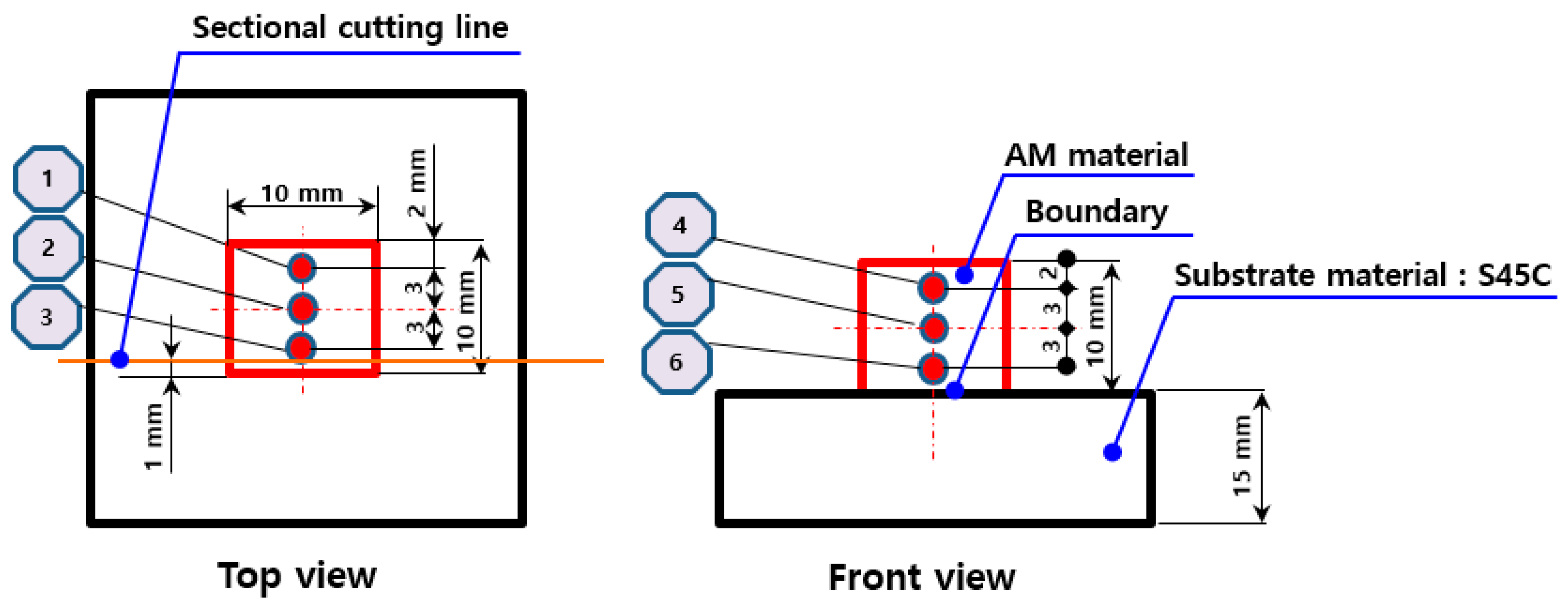
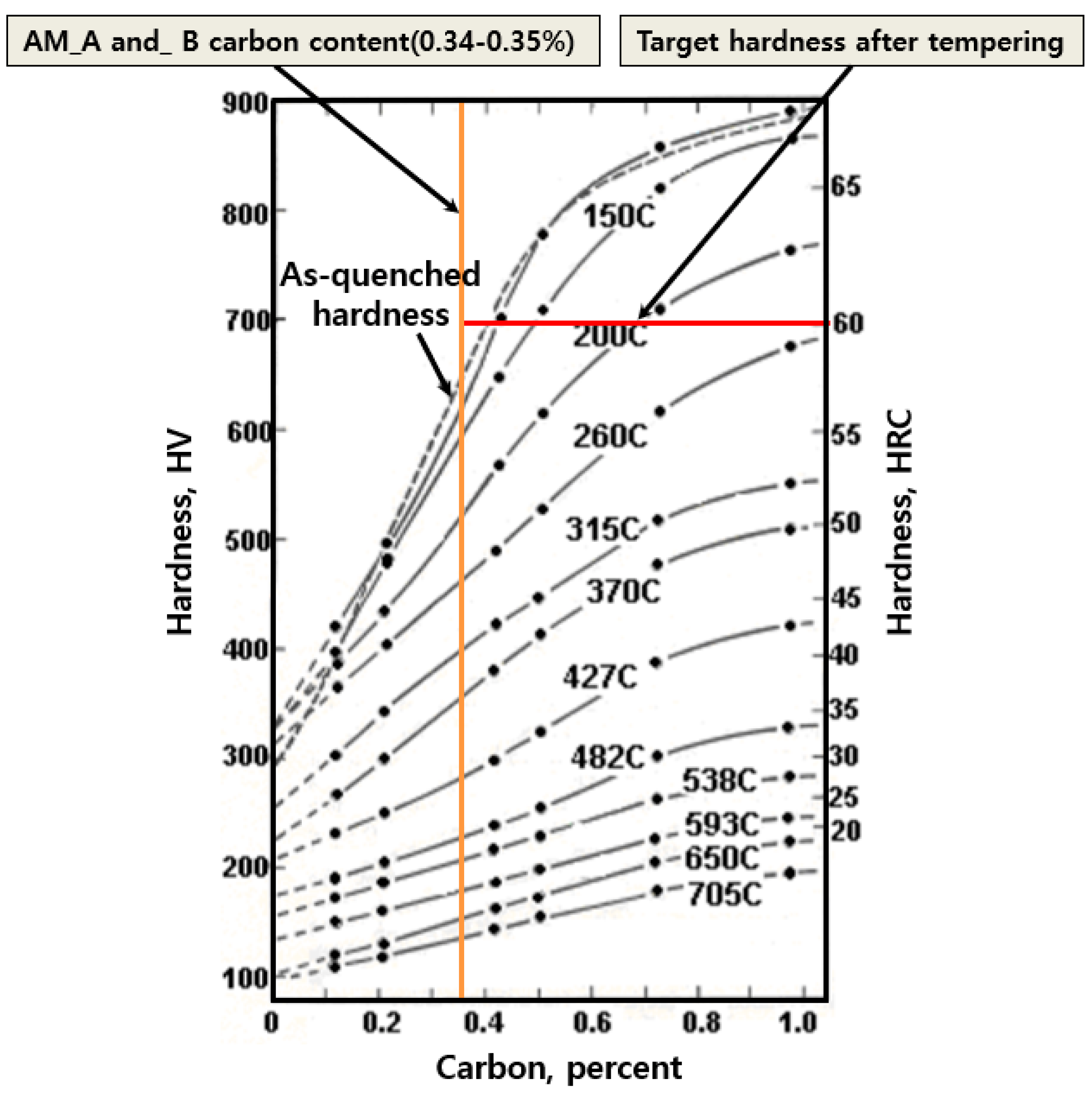


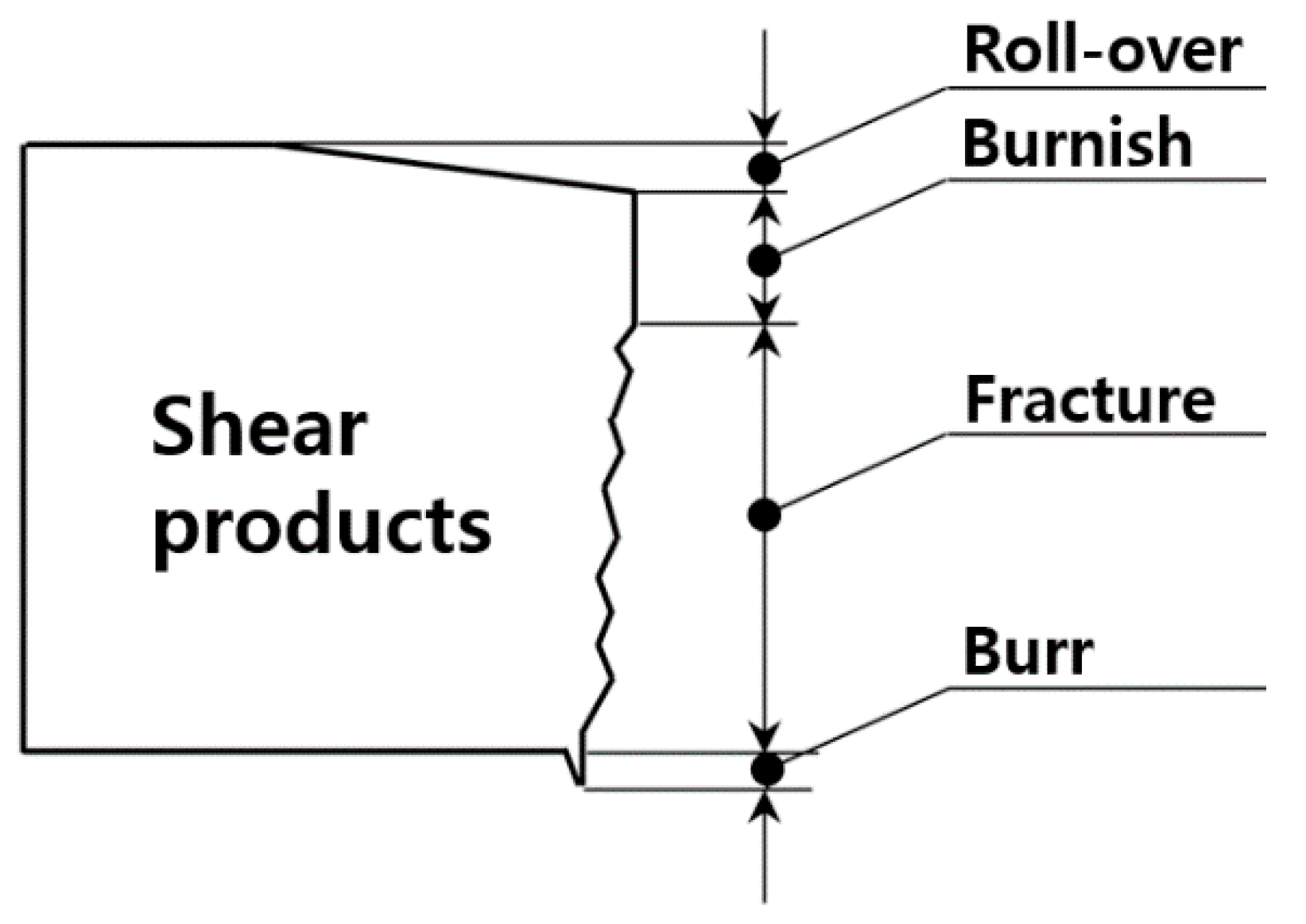
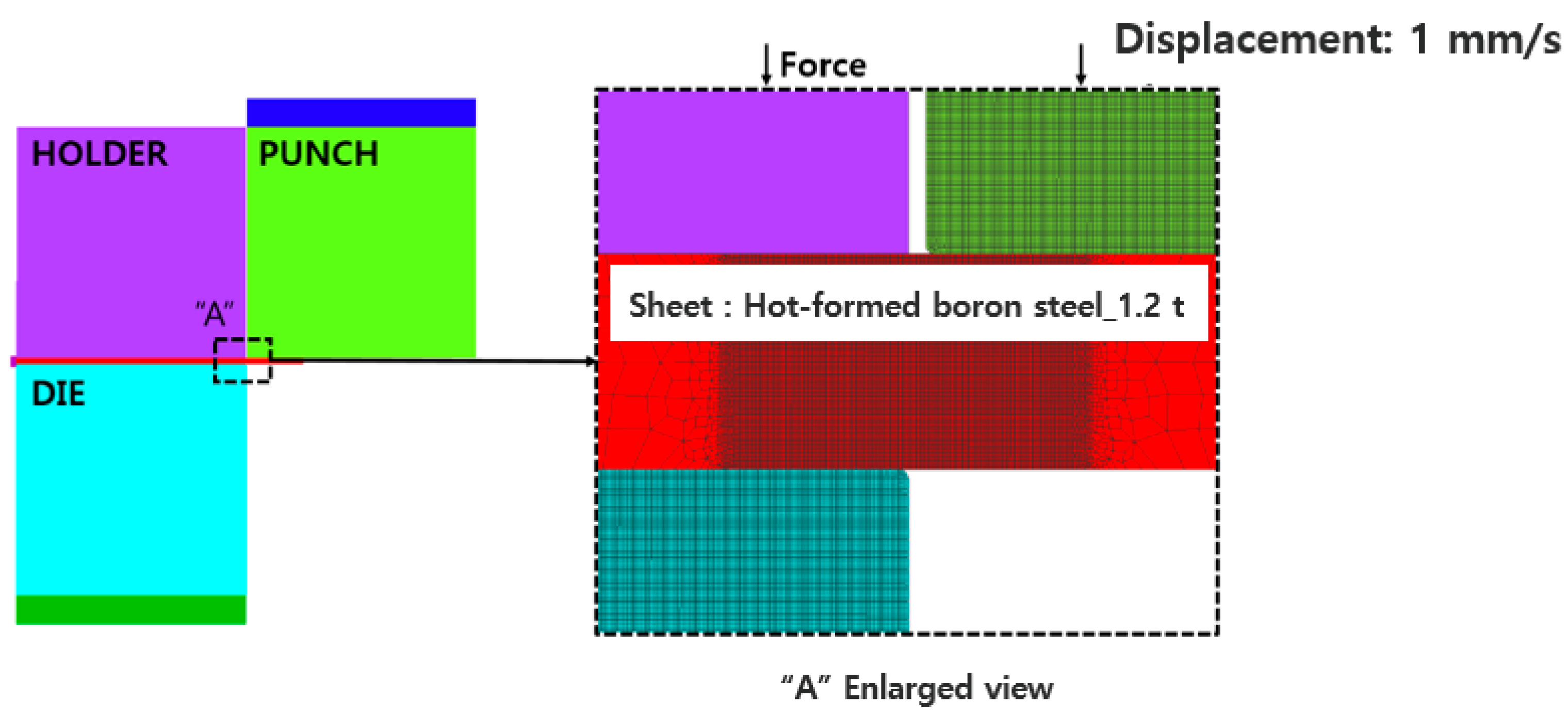
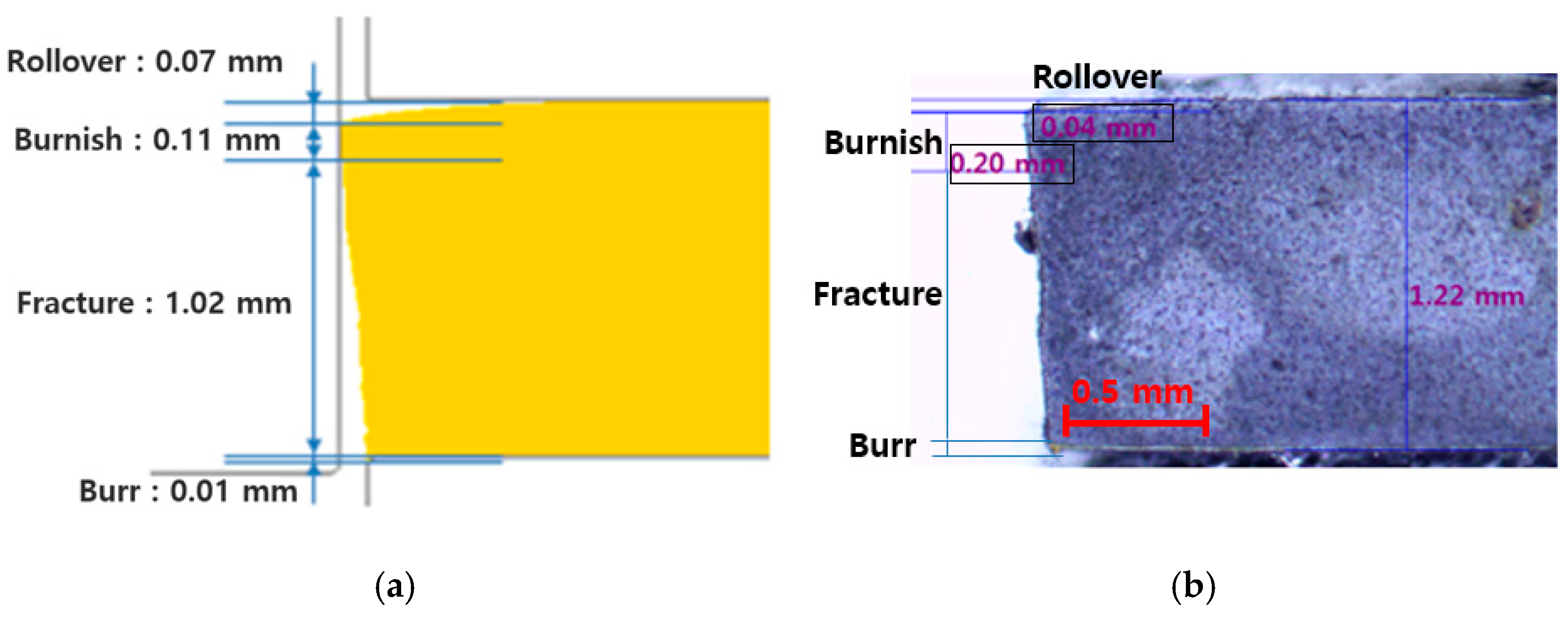
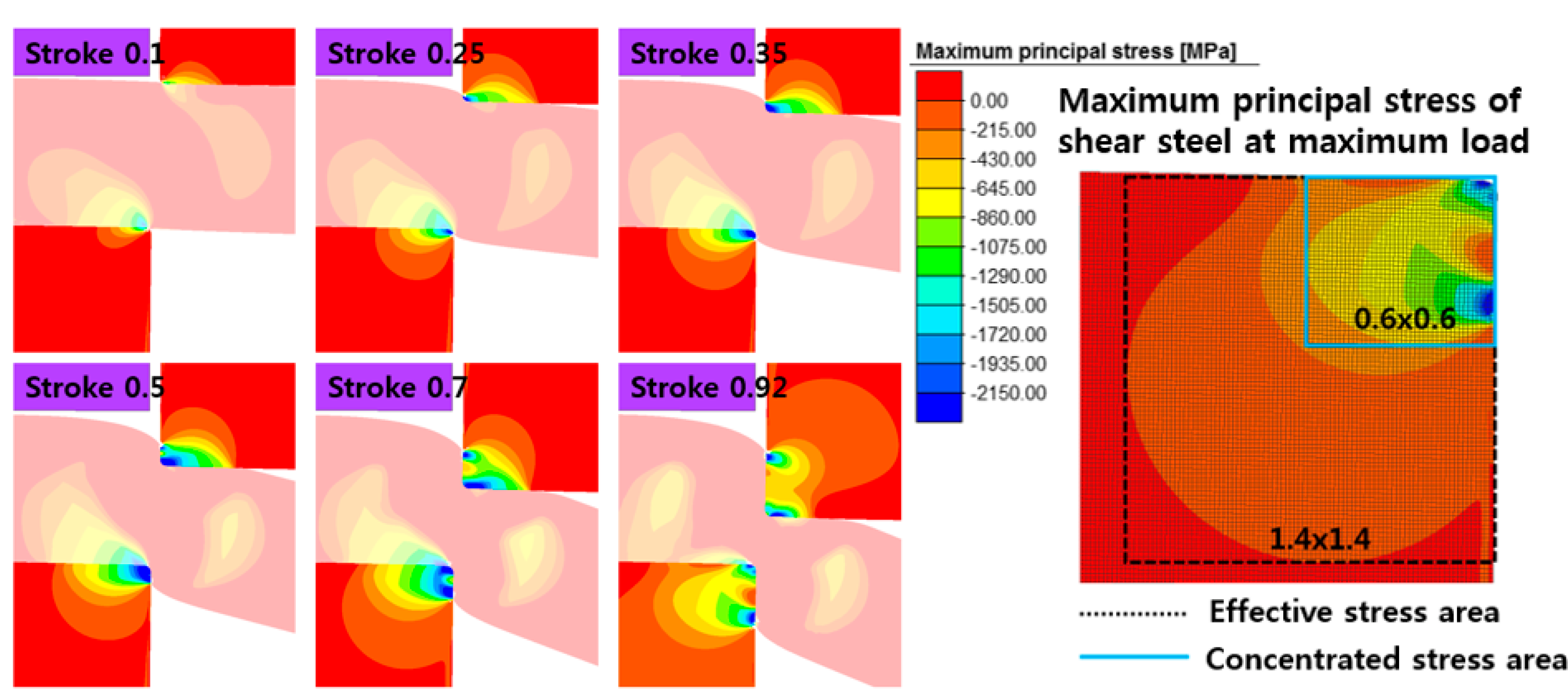

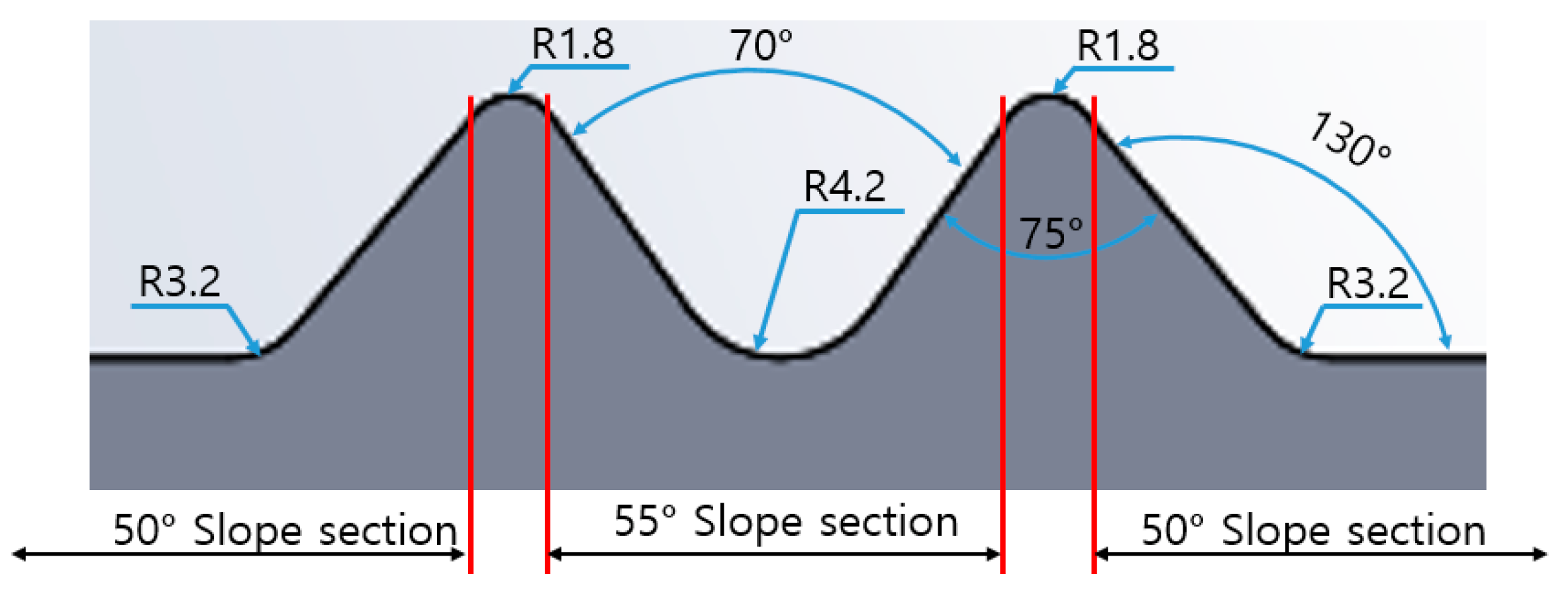



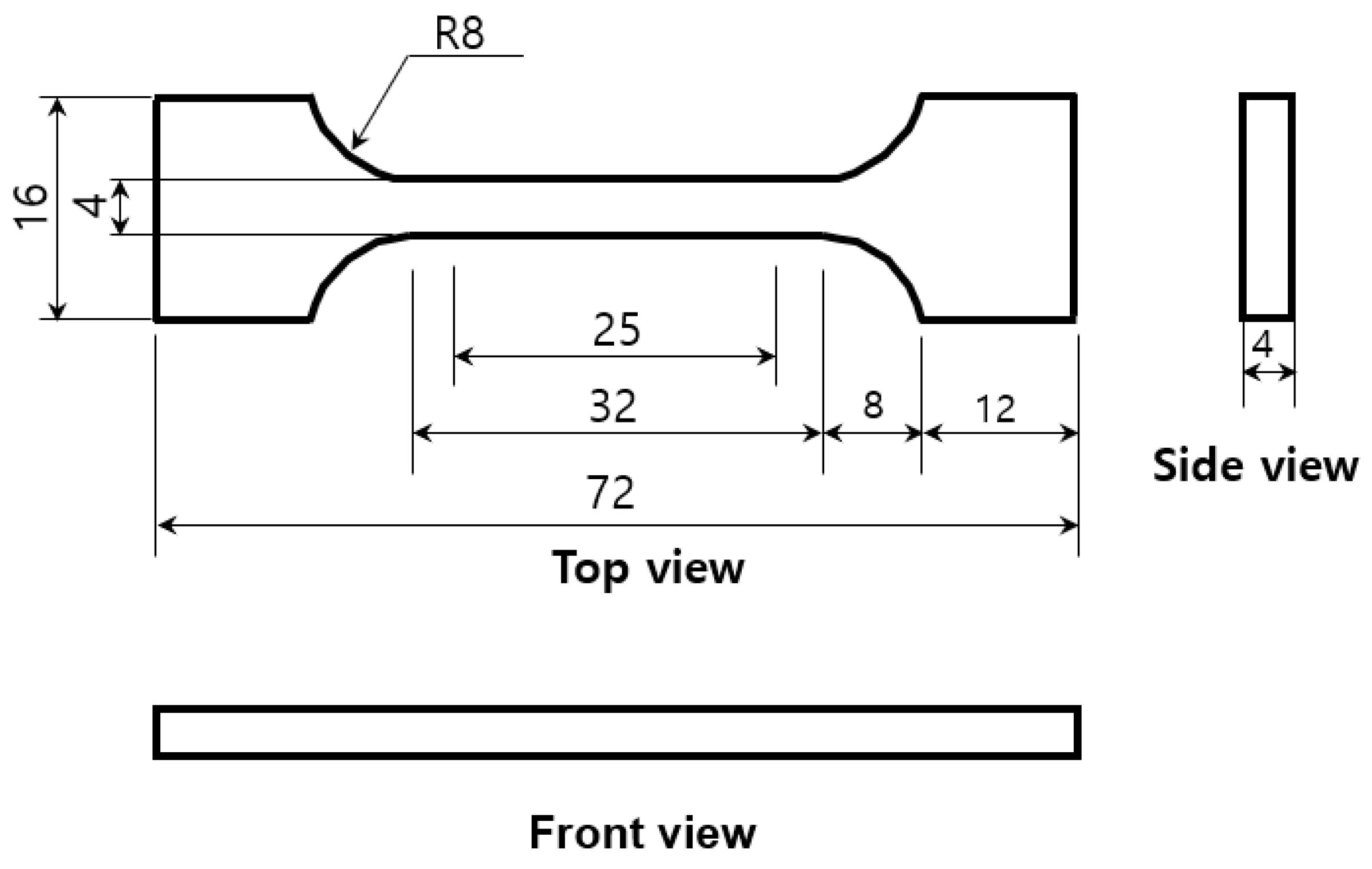
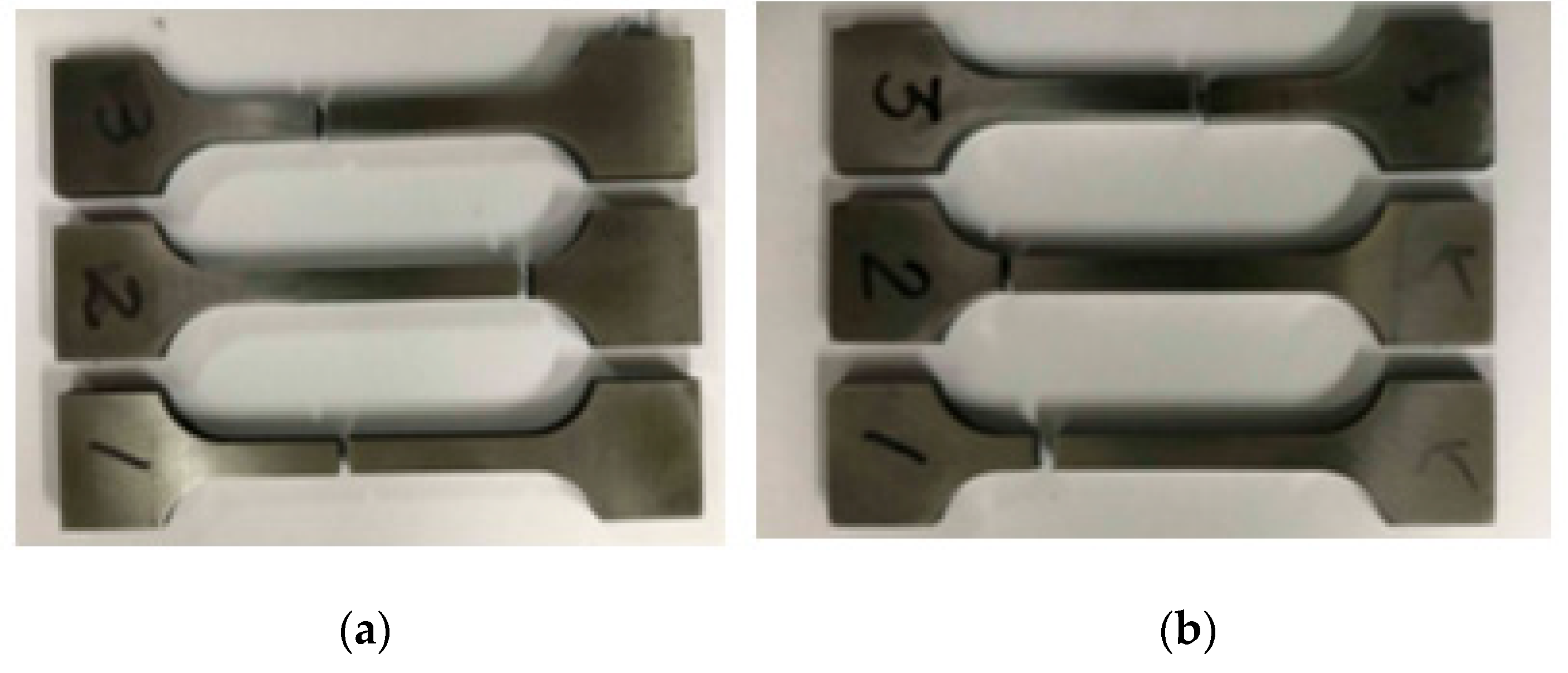
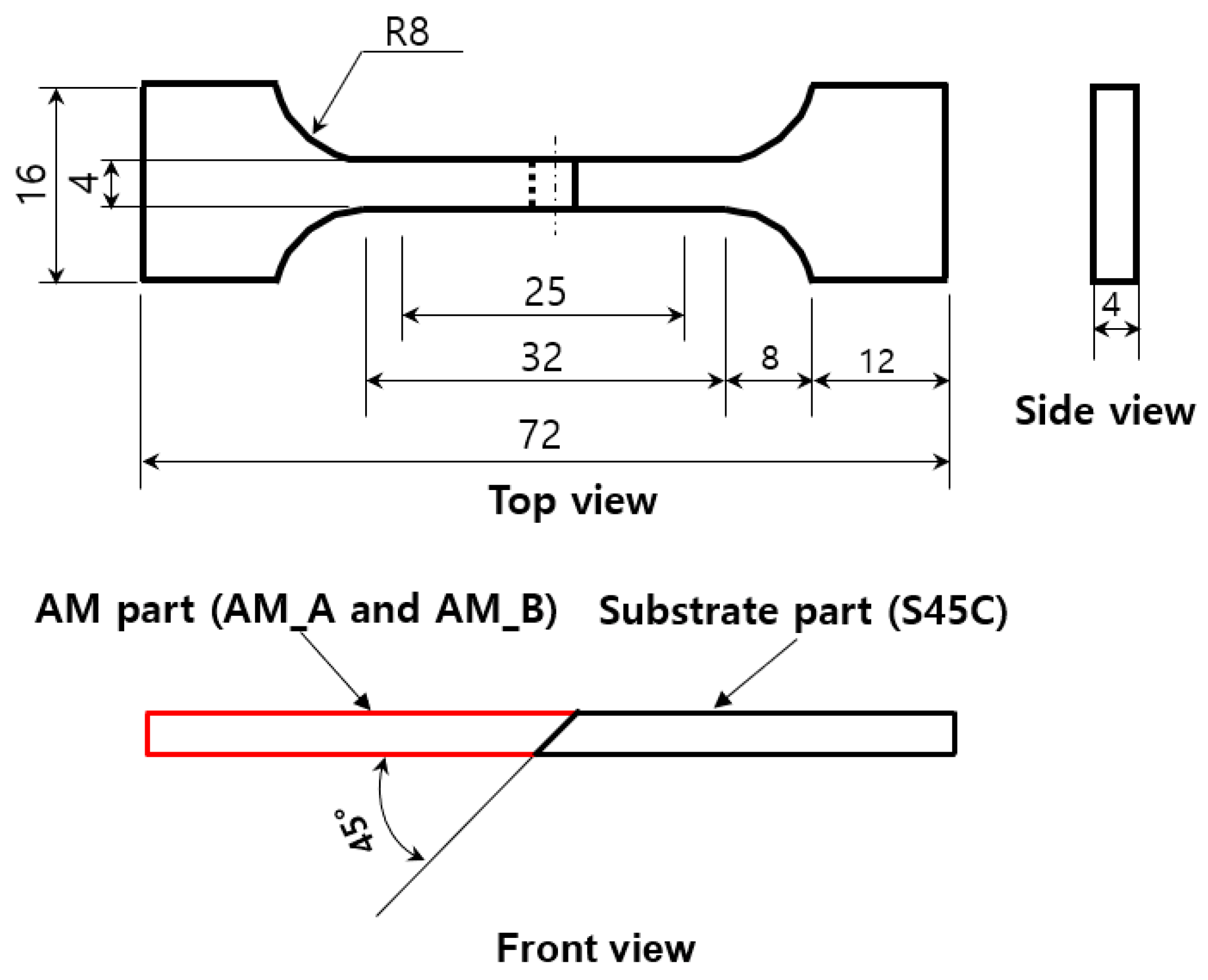
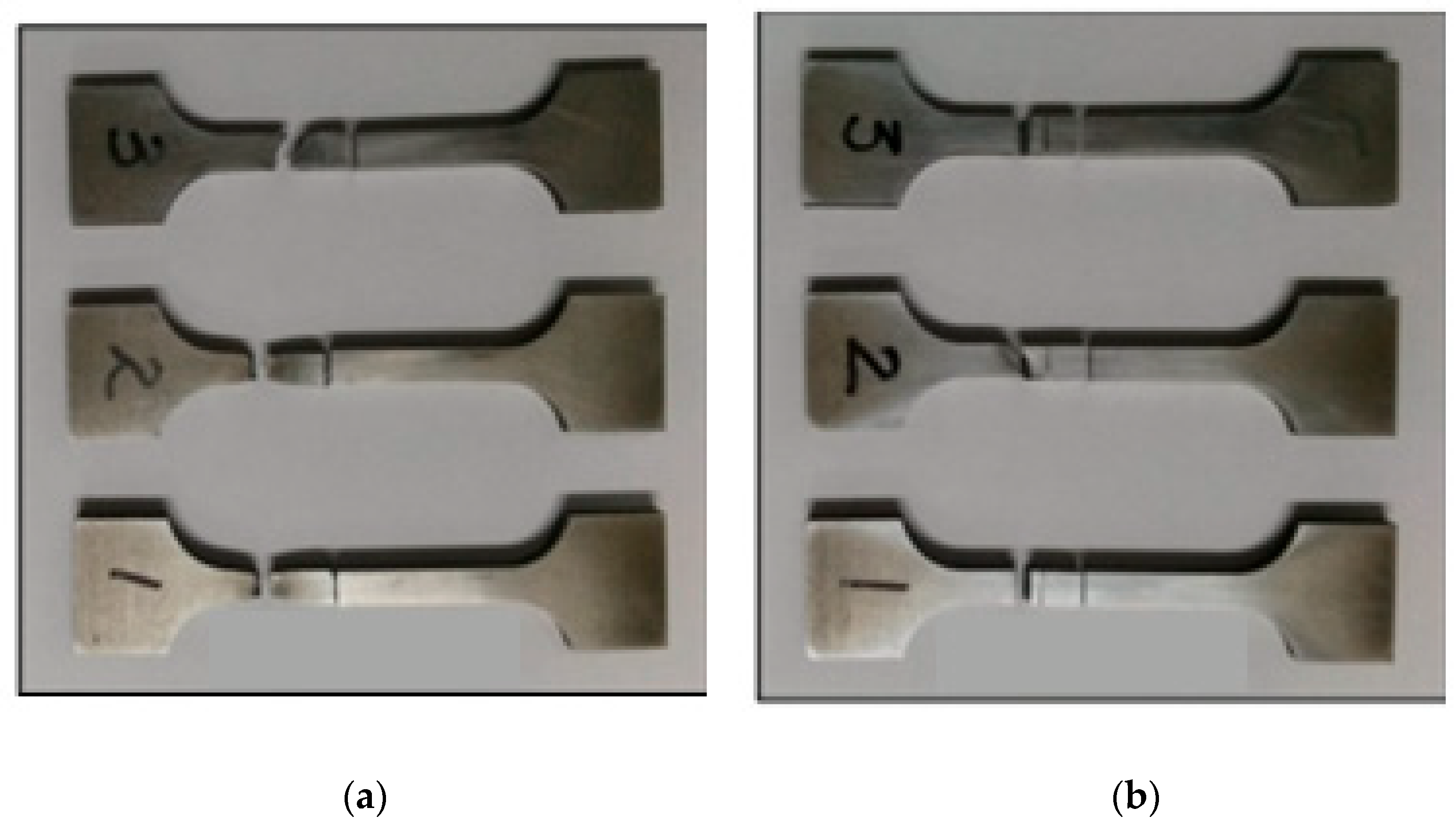
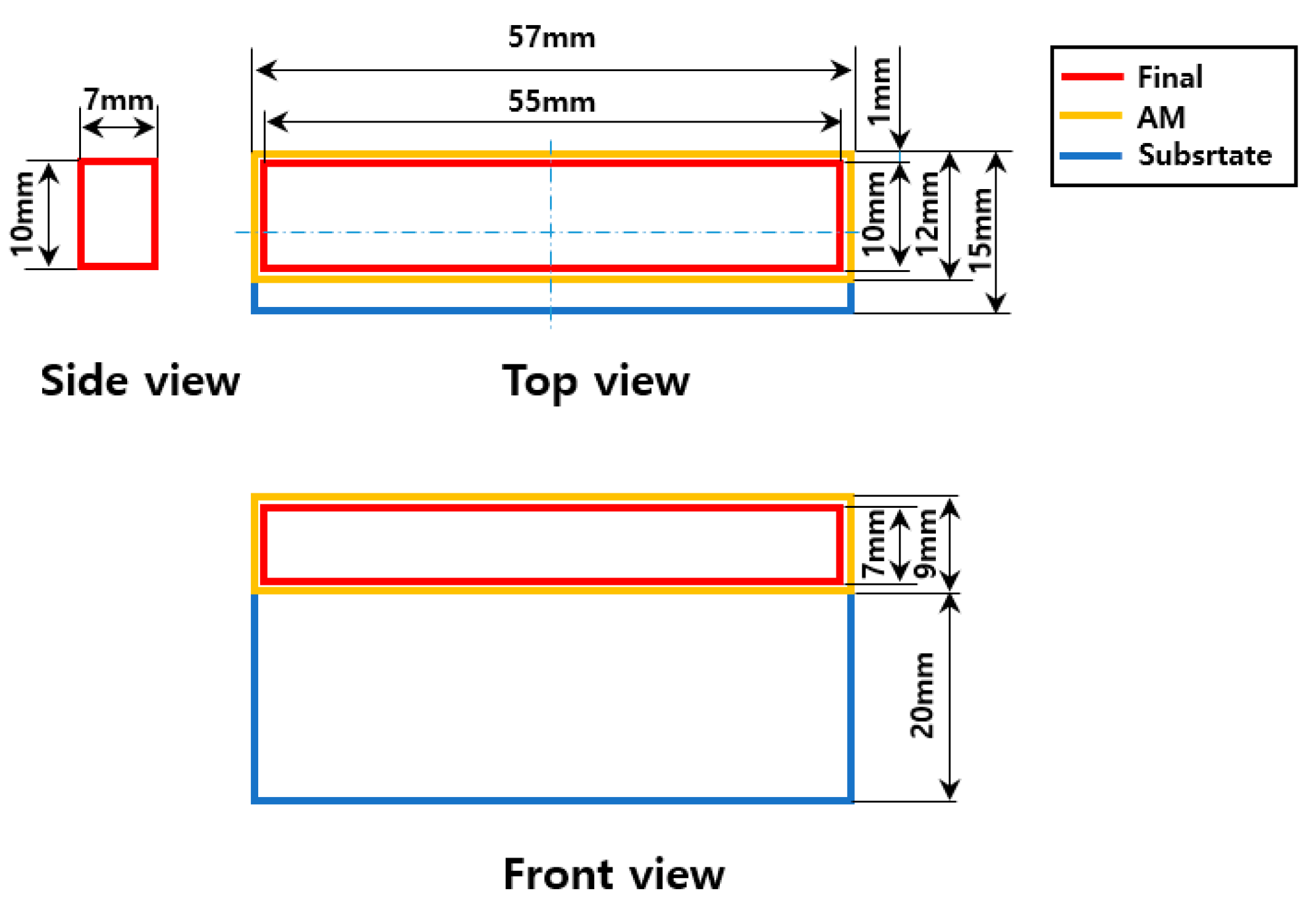
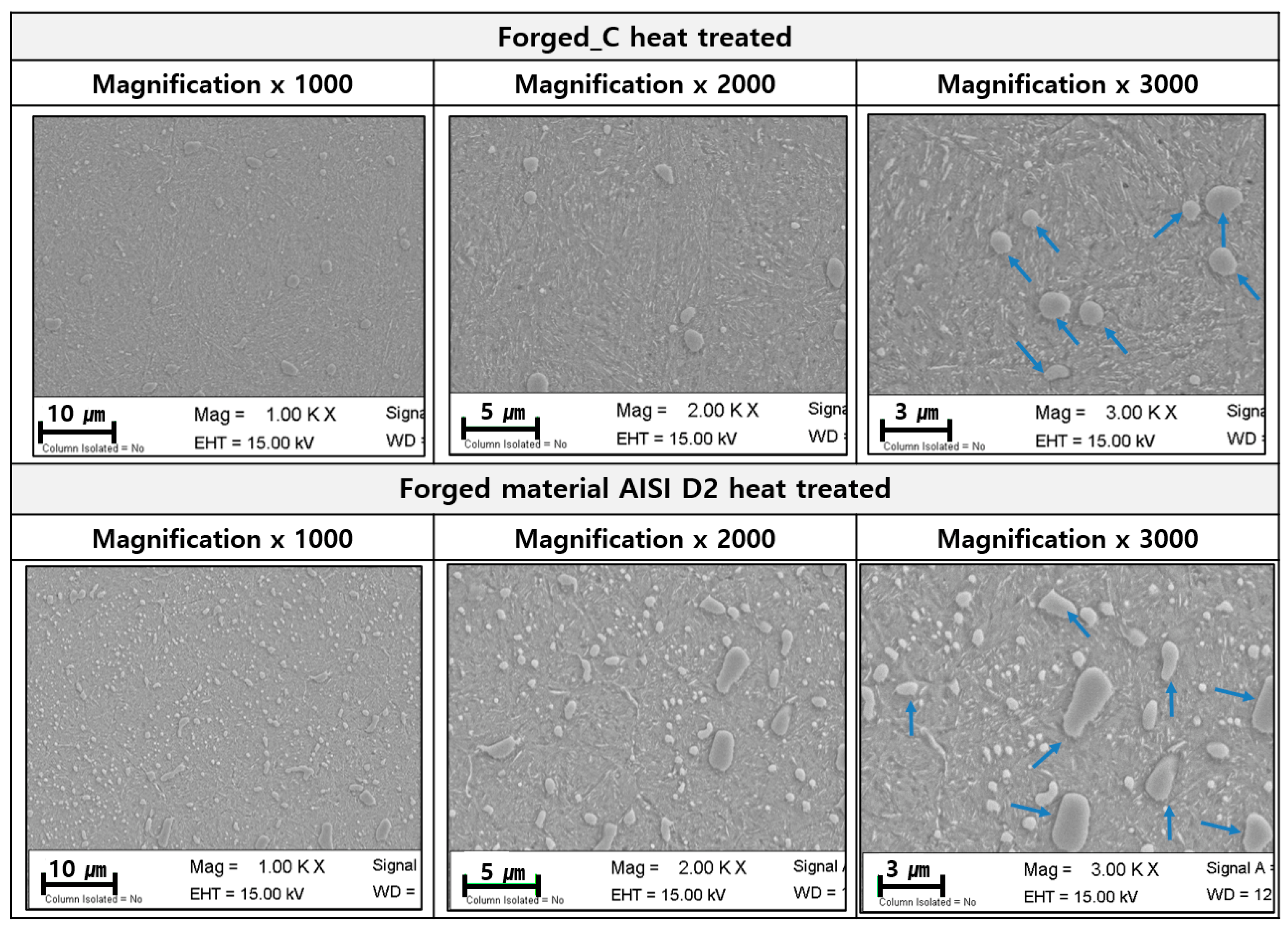
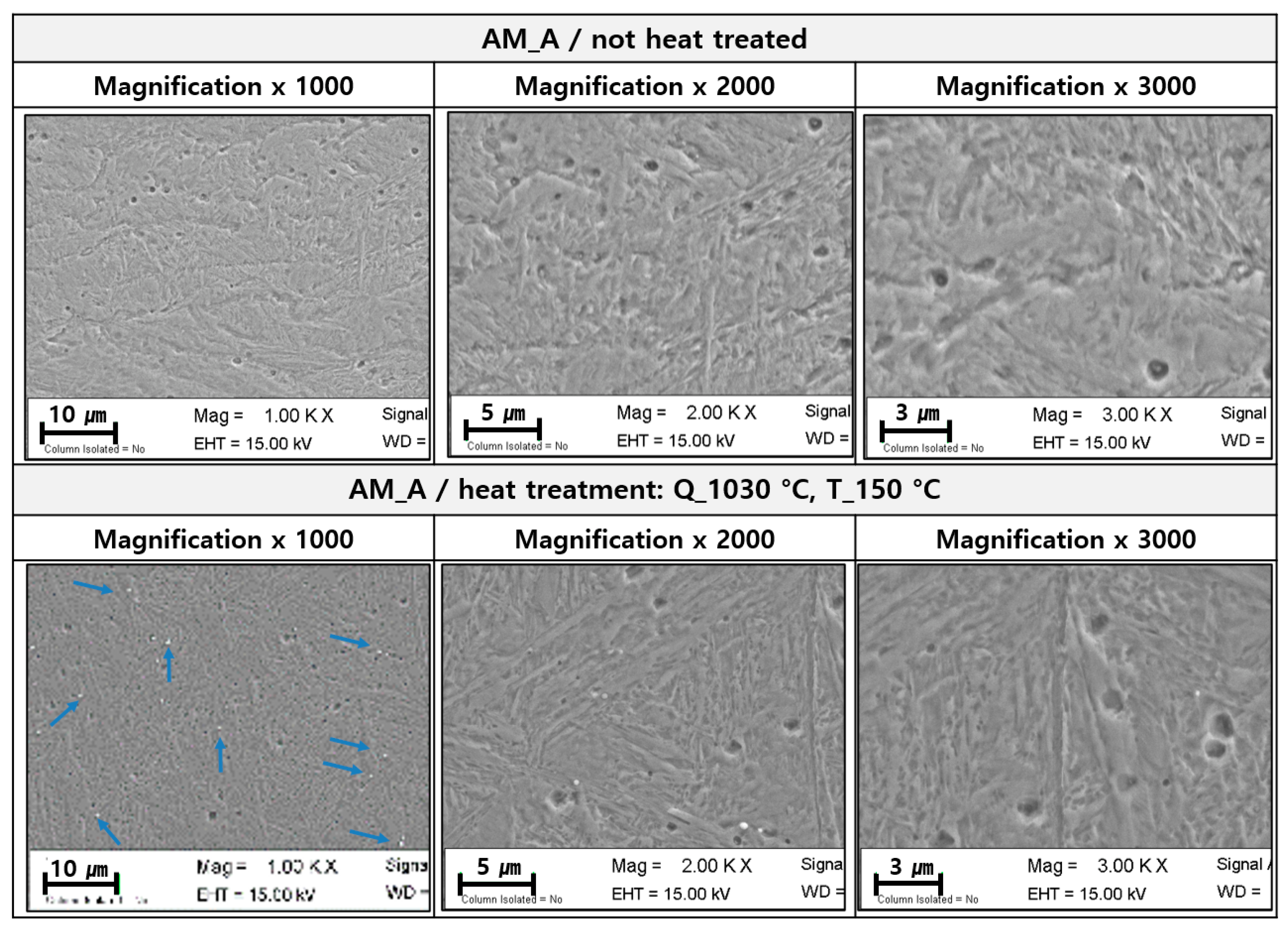
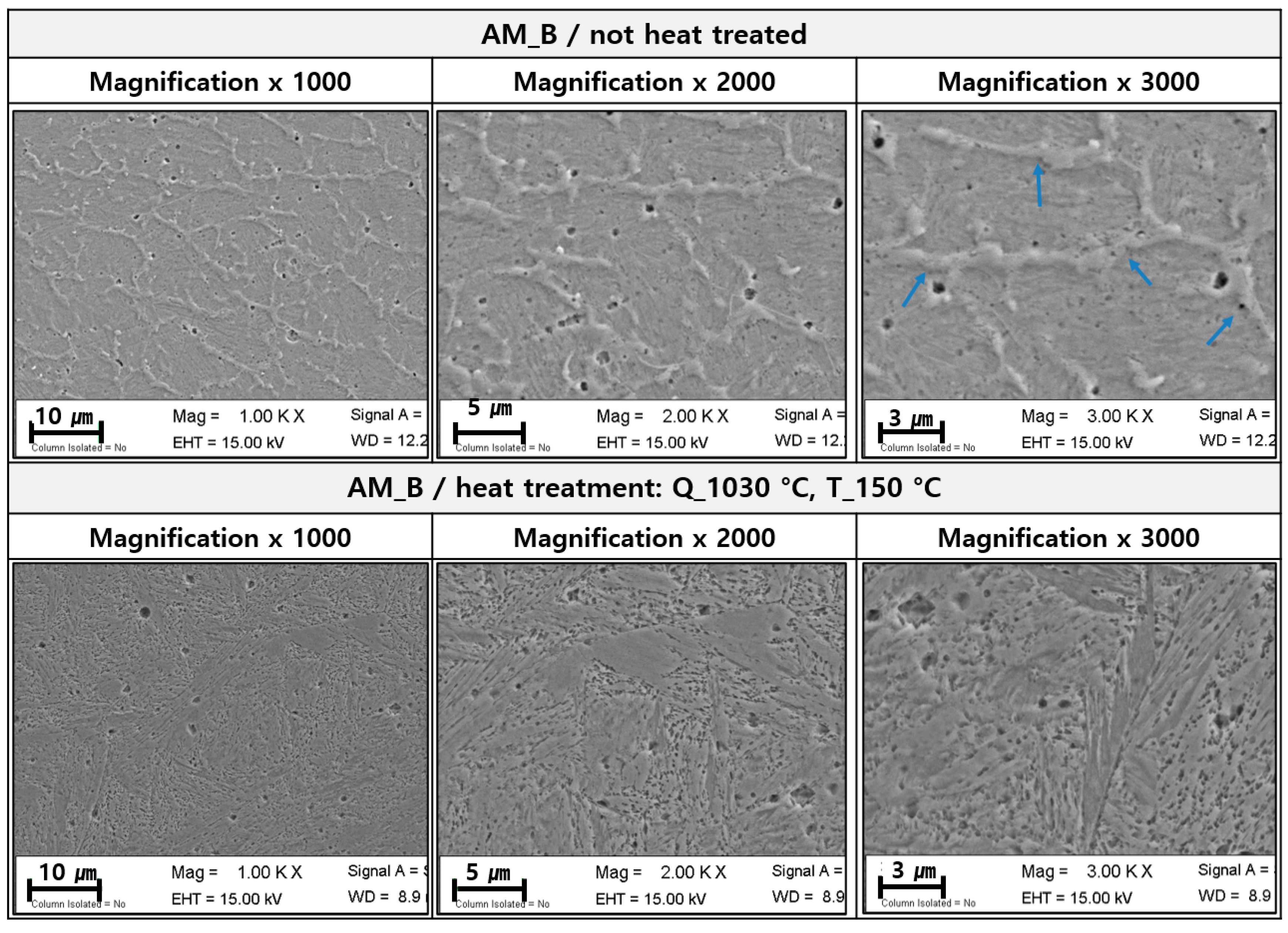


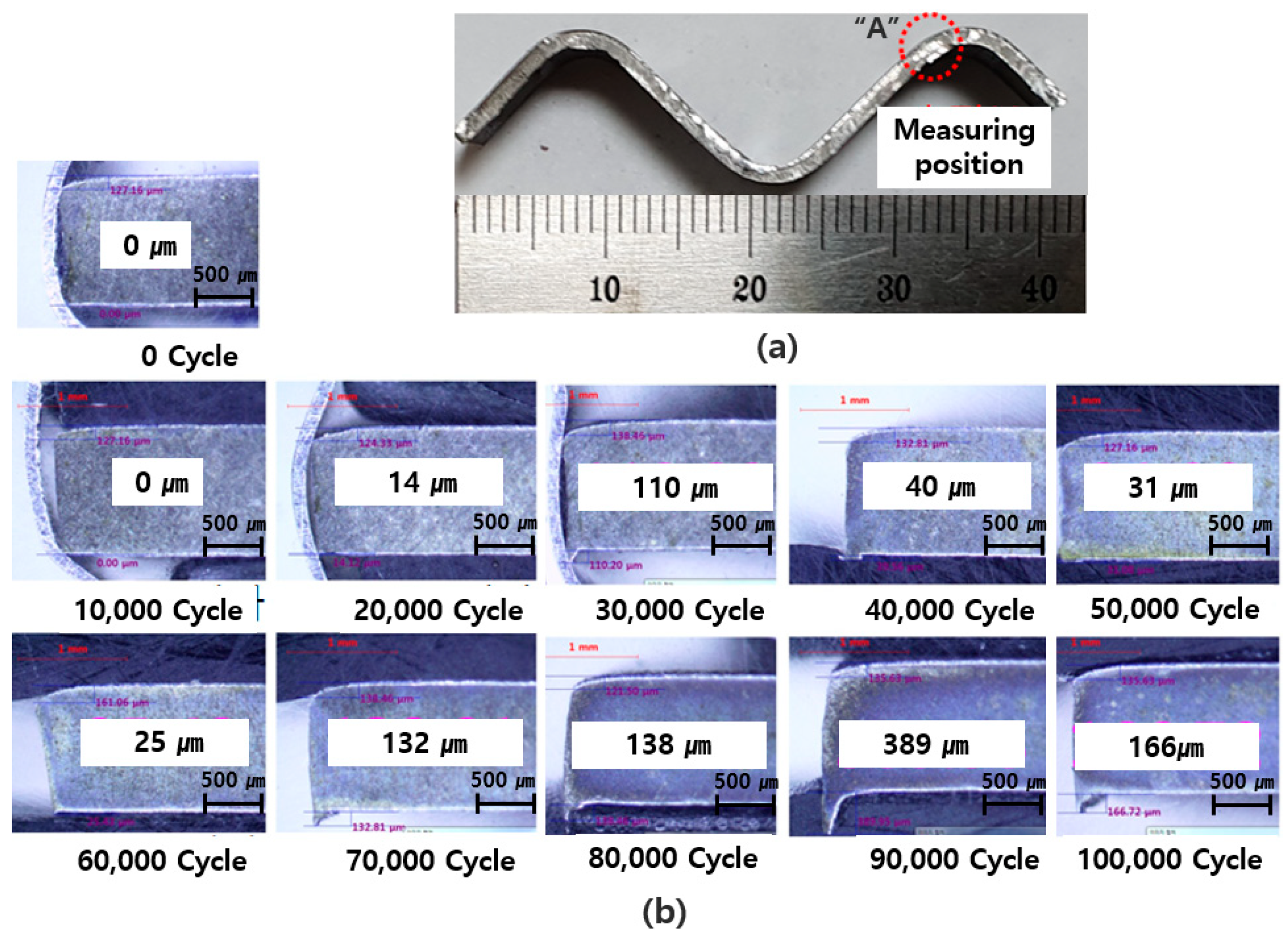
| Steel Grade | AISI or JIS | Chemical Composition (wt/%) | Heat Treatment and Hardness | Note | |||||||||
|---|---|---|---|---|---|---|---|---|---|---|---|---|---|
| C | Si | Mn | Cr | Mo | W | V | Co | Q.T. (a) | HRC | ||||
| Flame-hardened steel | 23F85 | 0.70–0.72 | 0.86–1.00 | 0.02–0.78 | 0.17–1.01 | 0.08–0.16 | 0.07–0.19 | Air | 56–60 | ||||
| KFH-1 | 0.75–0.80 | 0.95–1.05 | 0.70–0.80 | 1.00–1.10 | 0.20–0.25 | 0.03–0.05 | Air | 56–60 | |||||
| Tool steel | Carbon tool steel | W1-10 | 1.05 | 0.20 | 0.30 | Water | 57–63 | ||||||
| Alloy tool steel | SKS93 | 1.05 | 0.95 | 0.40 | Oil | 57–63 | |||||||
| SKS3 | 0.95 | 1.05 | 0.75 | - | 0.75 | Oil | 57–60 | ||||||
| D2 | 1.50 | 12.0 | 1.00 | 0.35 | Air | 57–63 | |||||||
| 8% Cr steel | 1.00 | 1.00 | 0.40 | 8.00 | 2.00 | 0.30 | Air | 57–63 | K340 | ||||
| High-speed tool steel | M2 | 0.85 | 4.15 | 5.00 | 6.30 | 1.90 | Oil | 58–64 | |||||
| SKH40 | 1.30 | 4.15 | 5.00 | 6.20 | 3.00 | 8.40 | Oil | 64–67 | S590 | ||||
| Matrix tool steel | YXR 3 | 0.60 | 1.50 | 0.40 | 4.30 | 2.90 | 1.80 | Oil | 58–61 | CALDIE, W360 | |||
| Material Classification | C | Cr | Mn | Si | Mo | V | Fe |
|---|---|---|---|---|---|---|---|
| AM_A | 0.2–0.5 | 8–10 | 0.38 | 2.3 | Balance | ||
| AM_B | 0.2–0.5 | 8–10 | 1.1 | 0.3 | 2.2 | Balance | |
| Forging_C | 0.7 | 5.0 | 0.5 | 0.2 | 2.3 | 0.5 | Balance |
| Material | Hardness (HRC) | Young’s Modulus (GPa) | Compressive Yield Strength (MPa) |
|---|---|---|---|
| Forging_C | 60–61 | 213 | 2230 |
| AM Parameter | Sample Name | |
|---|---|---|
| AM_A | AM_B | |
| Supplied powder (g/min) | 4.40–7.30 | 5.00–7.30 |
| Supplied powder gas (L/min) | 2.50 | 2.00 |
| Supplied shield gas (L/min) | 7.00 | 7.00 |
| Laser power (W) | 250–450 | 250–450 |
| Deposition speed (m/min) | 0.85 | 0.85 |
| Deposition height per layer (mm) | 0.25 | 0.25 |
| Deposition width pitch per layer (mm) | 0.50 | 0.50 |
| Laser beam diameter (mm) | 0.80 | 0.80 |
| Laser wavelength (nm) | 1060 | 1060 |
| Conditions | Laser Power (W) | Powder Supply (g/min) | Average of 6 Measurements (HRC) | |
|---|---|---|---|---|
| Surface | Section | |||
| 1 | 250 | 7.3 | 53.7 | 40.7 |
| 2 | 300 | 6.5 | 51.8 | 46.0 |
| 3 | 350 | 5.5 | 59.7 | 54.4 |
| 4 | 400 | 4.8 | 59.5 | 50.1 |
| 5 | 450 | 4.4 | 58.5 | 51.5 |
| Conditions | Laser Power (W) | Powder Supply (g/min) | Average of 6 Measurements (HRC) | |
|---|---|---|---|---|
| Surface | Section | |||
| 1 | 250 | 7.3 | 55.4 | 51.2 |
| 2 | 300 | 7.0 | 58.4 | 43.9 |
| 3 | 350 | 6.5 | 58.9 | 52.6 |
| 4 | 400 | 5.4 | 58.1 | 53.4 |
| 5 | 450 | 5.0 | 59.6 | 54.9 |
| AM Parameter | Sample Name | |
|---|---|---|
| AM_A | AM_B | |
| Supplied powder (g/min) | 5.5 | 5.0 |
| Supplied powder gas (L/min) | 2.50 | 2.00 |
| Supplied shield gas (L/min) | 7.00 | 7.00 |
| Laser power (W) | 350 | 450 |
| Deposition speed (m/min) | 0.85 | 0.85 |
| Deposition height per layer (mm) | 0.25 | 0.25 |
| Deposition width pitch per layer (mm) | 0.50 | 0.50 |
| Laser beam diameter (mm) | 0.80 | 0.80 |
| Laser wavelength (nm) | 1060 | 1060 |
| Material | Yield Strength (MPa) | Tensile Strength (MPa) | Elongation (%) |
|---|---|---|---|
| 22MnB5 | 1100 | 1598 | 8.91 |
| Conditions | Value |
|---|---|
| Clearance (mm) | 0.96 |
| Tool steel velocity (mm/s) | 1 |
| Friction factor | 0.1 |
| Critical damage value | 0.8 |
| Tool-steel compressive yield strength (MPa) | 2150 |
| Minimum sheet element (mm) | 0.0125 |
| Minimum tool element (mm) | 0.0156 |
| Sheet flow stress (MPa) |
| Sample Number | Applied Material | Heat Treatment |
|---|---|---|
| 1 | Substrate S45C + Forging_C | Heat treatment applied |
| 2 | Substrate S45C +AM_A | No heat treatment |
| 3 | Substrate S45C + AM_A | Heat treatment applied (Q, 1030 °C and T, 150 °C) |
| 4 | Substrate S45C +AM_B | No heat treatment |
| 5 | Substrate S45C + AM_A | Heat treatment application (Q, 1030 °C and T, 150 °C) |
| C | Si | Mn | P | S | Al | Nb + Ti | Cr + Mo | Cu | B |
|---|---|---|---|---|---|---|---|---|---|
| 0.23 | 0.40 | 1.30 | 0.02 | 0.01 | 0.015 | 1.00 | 1.00 | 0.20 | 0.01 |
| Material | Yield Strength (MPa) | Tensile Strength (MPa) | Elongation (%) |
|---|---|---|---|
| Docol 1500 M | 1220–1500 | 1500–1700 | 3 |
| Material | Coil Width (mm) | Pitch (mm) | Shear Speed (Strokes per Minute) | Note |
|---|---|---|---|---|
| Docol 1500 M | 50 | 4 | 40 | Applied to the initial 20 cycles and at specific cycles where the life evaluation was performed |
| B steel (22MnB5) | 50 | 15 | 40 | Applied to the entire test except for a specific cycle where the life evaluation was performed |
| Specimen No | AM_A | AM_B | ||
|---|---|---|---|---|
| Tensile Strength (MPa) | Elongation (%) | Tensile Strength (MPa) | Elongation (%) | |
| 1 | 1873 | 8.72 | 1713 | 7.37 |
| 2 | 1753 | 7.62 | 1771 | 8.37 |
| 3 | 1836 | 8.98 | 1749 | 7.93 |
| Average | 1820 | 8.44 | 1744 | 7.89 |
| Specimen No | AM_B | AM_B | ||
|---|---|---|---|---|
| Tensile Strength (MPa) | Elongation (%) | Tensile Strength (MPa) | Elongation (%) | |
| 1 | 646 | 9.70 | 635 | 9.52 |
| 2 | 647 | 9.89 | 506 | 9.40 |
| 3 | 648 | 9.65 | 584 | 9.48 |
| Average | 647 | 9.75 | 575 | 9.47 |
| Specimen Manufacturing Conditions | Shock Absorption Energy (J) | Hardness (HRC) |
|---|---|---|
| Forging_C/heat treatment applied | 104.0 | 59.8 |
| AM_A/no heat treatment | 22.0 | 59.3 |
| AM_A/heat treatment: Q_1030 °C, T_150 °C | 11.0 | 60.3 |
| AM_A/heat treatment: Q_1030 °C, T_520 °C | 6.3 | 57.8 |
| AM_B/no heat treatment | 88.5 | 60.2 |
| AM_B/heat treatment: Q_1030 °C, T_150 °C | 85.5 | 60.0 |
| AM_B/heat treatment: Q_1030 °C, T_550 °C | 53.3 | 57.1 |
Publisher’s Note: MDPI stays neutral with regard to jurisdictional claims in published maps and institutional affiliations. |
© 2022 by the author. Licensee MDPI, Basel, Switzerland. This article is an open access article distributed under the terms and conditions of the Creative Commons Attribution (CC BY) license (https://creativecommons.org/licenses/by/4.0/).
Share and Cite
Hong, M.-P. Hot Stamping Parts Shear Mold Manufacturing via Metal Additive Manufacturing. Appl. Sci. 2022, 12, 1158. https://doi.org/10.3390/app12031158
Hong M-P. Hot Stamping Parts Shear Mold Manufacturing via Metal Additive Manufacturing. Applied Sciences. 2022; 12(3):1158. https://doi.org/10.3390/app12031158
Chicago/Turabian StyleHong, Myoung-Pyo. 2022. "Hot Stamping Parts Shear Mold Manufacturing via Metal Additive Manufacturing" Applied Sciences 12, no. 3: 1158. https://doi.org/10.3390/app12031158
APA StyleHong, M.-P. (2022). Hot Stamping Parts Shear Mold Manufacturing via Metal Additive Manufacturing. Applied Sciences, 12(3), 1158. https://doi.org/10.3390/app12031158





